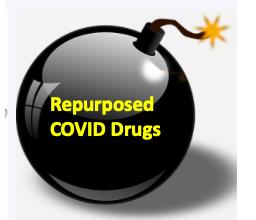Six months ago it seemed that every other lab had a kick-ass, re-purposed drug that was only weeks away from putting the hurt on COVID. How did that work out?
It's a good thing that Pfizer and Moderna (and maybe Astra-Zeneca if they can figure out how to divide by two) came up with vaccines, or else we'd be looking at an indefinite period of some very bleak times. We got absolutely nothing from any re-purposed drug, something ACSH advisor Dr. Katherine Seley-Radtke, a professor at UMBC (1), and I discussed back in August:
I think it is a huge waste of time testing most of them. Testing antiviral drugs? Yes, absolutely. Testing random drugs that aren’t direct-acting antivirals is just wasting valuable time that could be focused on finding a cure.
K. Seley-Radtke, 8/13/20
She was right. Of all the drugs that showed "so much promise" back in March, exactly zero of them have been approved by the FDA to treat COVID. Even remdesivir, which isn't exactly re-purposed (3), limped along for a while. As I discussed in September, its benefit was modest at best, but it turned out to be even less than modest. Only a month following FDA approval of the drug, the WHO recommended against its use based on data from the SOLIDARITY trial which studied remdesivir, hydroxychloroquine, lopinavir, and Interferon:
These Remdesivir, Hydroxychloroquine, Lopinavir and Interferon regimens appeared to have little or no effect on hospitalized COVID-19, as indicated by overall mortality, initiation of ventilation and duration of hospital stay.
H. Pan, et. al., medRxiv, October 15, 2020 https://doi.org/10.1101/2020.10.15.20209817
(More than a dozen other re-purposed drugs were studied. You can find an up-to-date summary of them here.)
Why did these drugs fail? For the small molecule (non-biological) drugs the problem was potency. The drugs couldn't inhibit SARS-CoV-2 at a concentration that could be reasonably achieved by a pill. I put together a table (below) that qualitatively relates drug EC50 concentrations and how potent that drug is. The lower the EC50 the more potent the drug. The problem with the re-purposed drugs is that they exist in the shaded area – modest potency.

Approximate potencies of drugs. The re-purposed COVID drugs are in the area highlighted in blue - the least potent drugs.
There are many factors that go into the decision of whether a drug is useful and safe. Re-purposed drugs have a distinct advantage over experimental drugs in that safety and other pharmacological information (e.g., oral vs. IV administration, side effects, drug-drug interactions) are available. But there is a disadvantage as well. Since these drugs have been approved for other diseases and conditions it would be a remarkable coincidence if they worked for an entirely different purpose from the one they were designed. In other words, if a drug is effective against malaria at dose X it is very unlikely to be effective against an entirely different target (a virus) at that same dose. If the effective dose against the virus is 1000X then we're talking about a pill the size of a casaba melon. And with such a large dose comes side effects that were either minor or not seen at the therapeutic dose for malaria.
All this goes to show how difficult it is to discover new drugs. People who hoped that we'd have an effective COVID drug in a few months were either naive or uninformed. From the time HIV was discovered, it took 14 years until the first effective drug hit the market. It took 22 years for hepatitis C.
This isn't to say that someone might not stumble across a useful drug but it will require extraordinary luck, with one exception, which was emphasized by Professor Seley-Radtke:
[It is] is a huge waste of time testing most of [repurposed drugs]. Testing antiviral drugs? Yes, absolutely.
And that is where a COVID drug, if one can be found at all, will almost certainly come from – re-purposed or new antiviral drugs.
Fortunately, we have vaccines with 95% efficacy, which is nothing short of miraculous. Roll up your sleeves.




